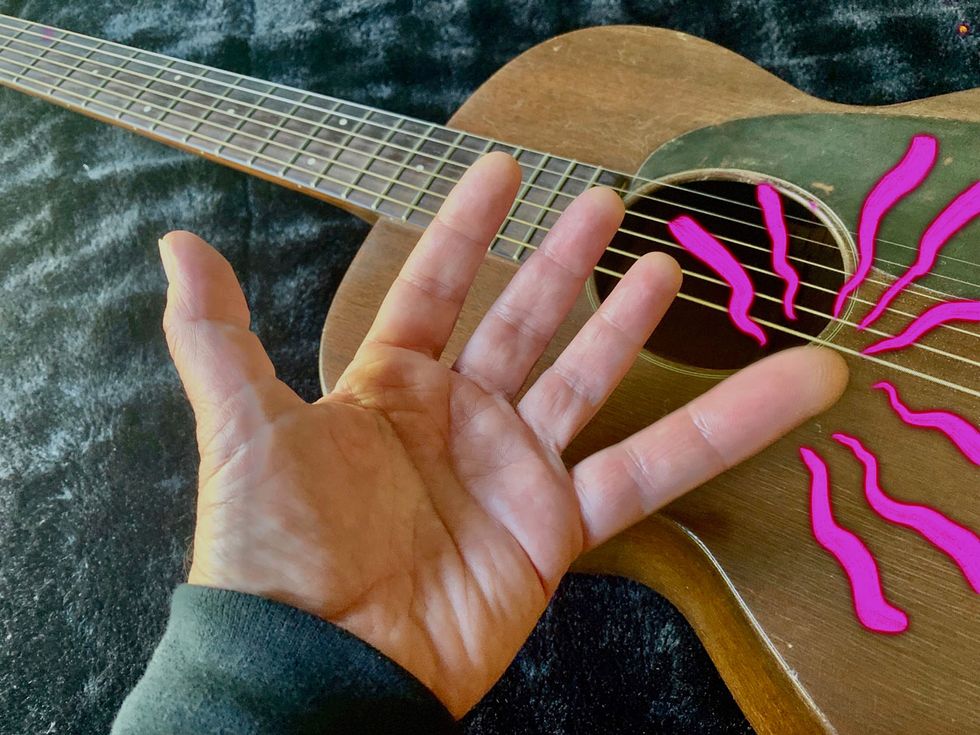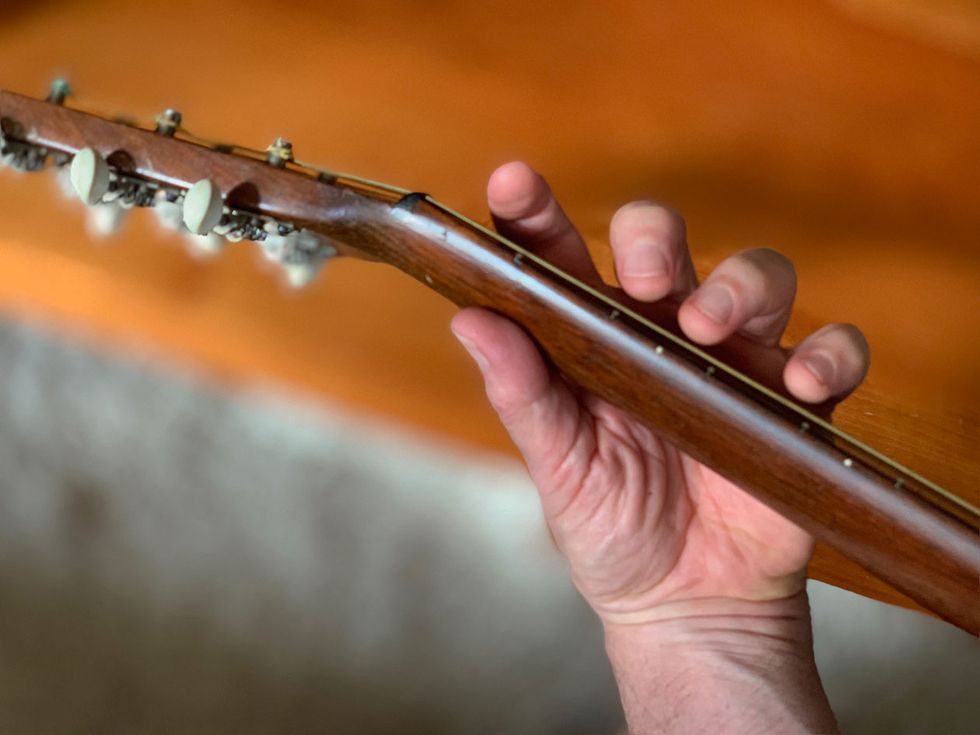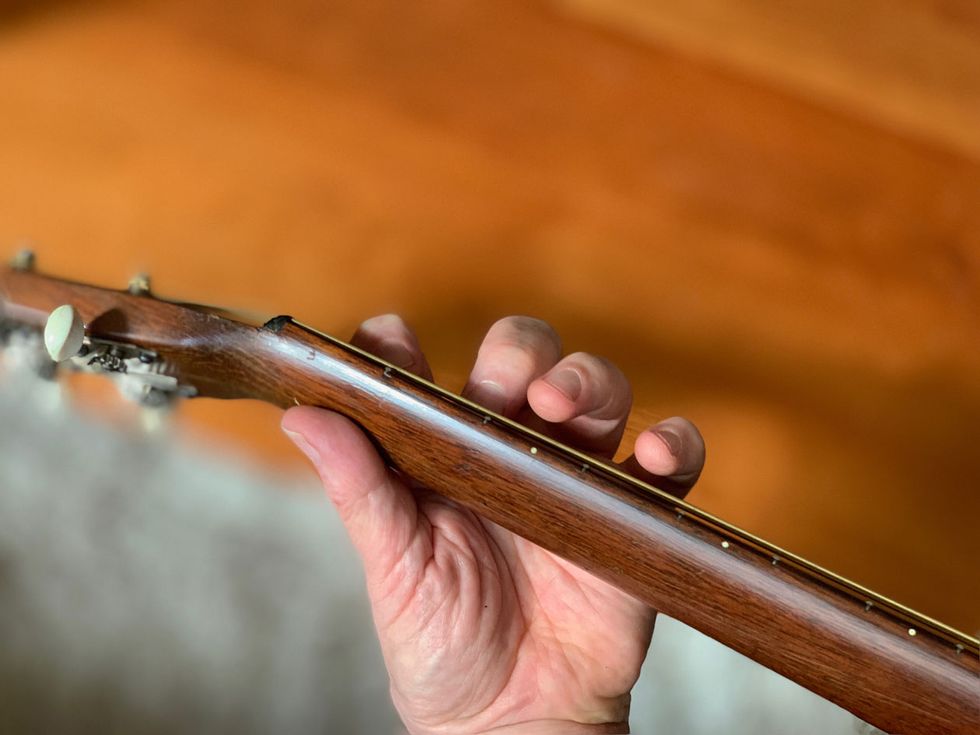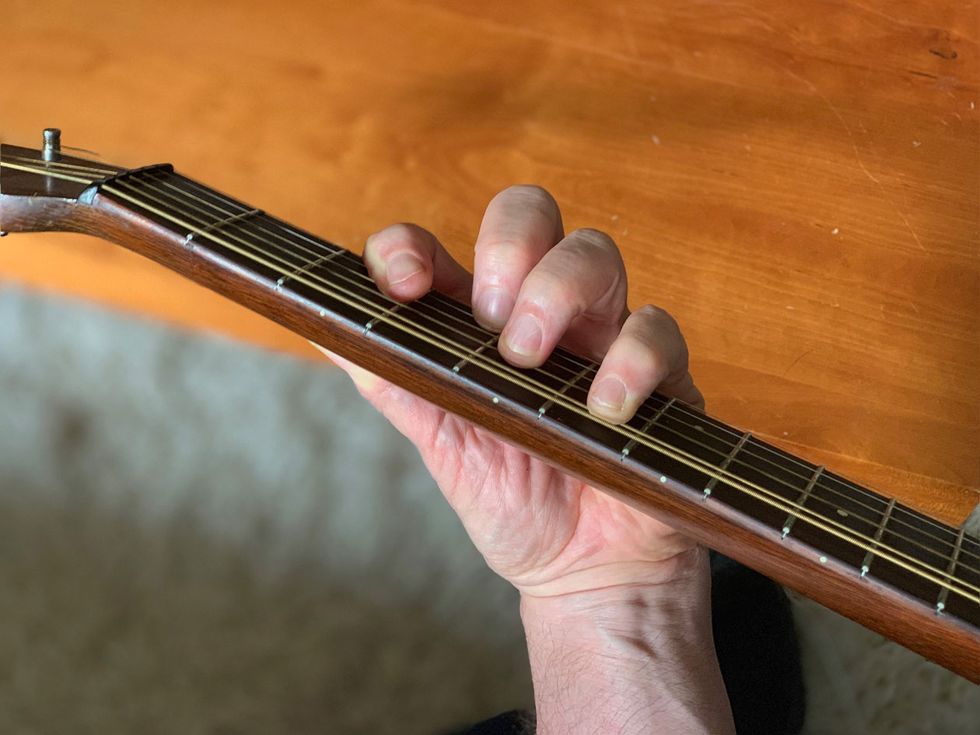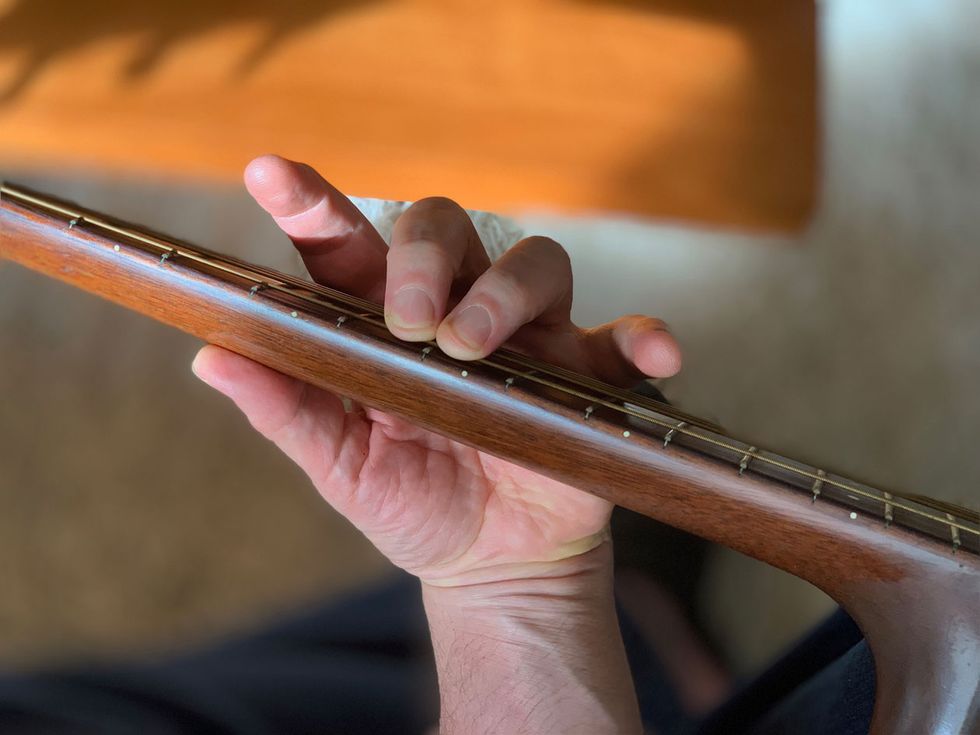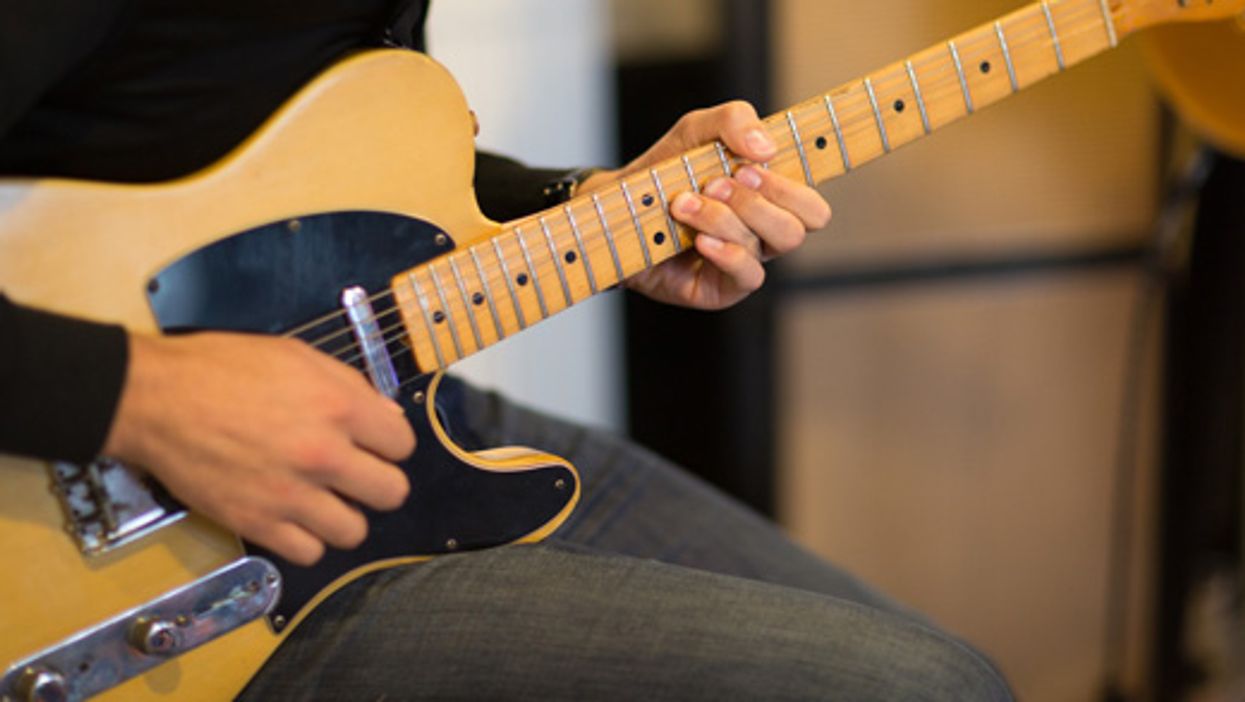This lesson will improve the strength and flexibility of your most subversive finger: the fretting-hand pinky.
Okay, I’m partly kidding about the “most subversive finger” thing. Technically, you don’t even need the finger to be a good player. Many influential guitarists seldom use the digit, especially not for single-note soloing. That’s often true for blues-rock and classic rock players from the ’60s and ’70s, who tended to restrict their note choices to pentatonic box patterns. The fact that Eric Clapton almost never uses his pinky doesn’t seem to have hindered his career.
But if you’re satisfied playing only blues-box notes, you’re probably reading the wrong lesson. By my thinking, the fact that the pinky is the least-used fretting finger is reason enough to employ it more often. It’s the pinky that stretches out of position to claim the weird, cool, and unexpected notes. It’s the best finger for reaching outside the box.
Delicate by Design
Yes, the pinky is your weakest finger. It’s shorter than the others, with less muscle and bone mass. But these exercises narrow the gap.
But first, a few words of caution about these challenging workouts. Since you may be using unfamiliar muscles in unfamiliar ways, you can definitely injure your hand by practicing too long or too hard. Also, some of these techniques may seem impossible at first, which can discourage you from cultivating them. So before proceeding, do yourself a favor and take this three-point pledge:
- I will take frequent breaks, especially if I experience hand pain.
- I will have reasonable expectations. I won’t get completely discouraged when my relatively undisciplined pinky displays a mind of its own.
- I won’t even think about speed. I’ll go as slowly as needed—and that can be very slow.
Let’s start with the six single-note studies in Ex. 1 through Ex. 6. Each one features a different permutation of the four fretting-hand fingers, played once on each string. Each pattern starts with your fourth finger. Practicing these builds strength and independence while stretching the ligaments between your fourth and third fingers.
Click here for Ex. 1
Click here for Ex. 2
Click here for Ex. 3
Click here for Ex. 4
Click here for Ex. 5
Click here for Ex. 6
Some tips: Try to let your four fingers hover above the first four frets, as in Photo 1, and keep finger motion to a minimum. That’s easier said than done—your pinky may rise inches above the fretboard each time you lift it. This is totally normal. Reining in that unnecessary motion can take months or years.
Photo 1
Also, be sure to listen. The goal is to play every note with equal intensity and duration. Make sure that the pinky notes sustain as long as the others. Pay particular attention to the first and last notes of each four-note pattern. The fourth note played on each string should ring out till the instant you strike the first note on the adjacent string. Practice with a metronome, but don’t speed it up until your performance is consistent. I’ve notated these as eighth-notes, with two notes per metronome click. But you may prefer to start out playing each note as a long, four-click whole note.
If you can’t yet maintain that four-fret span, simply play the exercises higher up the neck where the frets are closer together. You might start between the 9th and 12th frets, working down fret by fret as your hand grows accustomed to the span.
Yes, having large hands is a plus here. But even kids and small-handed adults can cultivate wide stretches like this. Remember, for every huge-handed Hendrix or Buckethead, there’s a tiny-fingered Danny Gatton or Angus Young. Size matters, but not all that much.
At this point you may want to stop before tackling the other examples. Really! These first exercises may keep you busy for weeks. Don’t rush it.
Spider Fingers
In Ex. 7 you spider walk across the strings using only your third and fourth fingers. If you haven’t tried an exercise like this before, this may be incredibly difficult—but only at first. This exercise improves the strength, independence, and reach of your pinky. As before, try to match the tone and duration of every note, and play as legato (connected) as possible. Again, I’ve notated these as eighth-notes, but it may be a good idea to sustain each note for several metronome clicks when you’re starting out.
Click here for Ex. 7
Measures 3 and 4 are the same as the first two measures but played one fret higher. You can continue climbing up the neck like this. Or if the stretch between the third and fourth fingers is too difficult for now, start higher on the neck and work downward.
In the unlikely event that this is too easy, you can increase the intensity by stationing your index finger on the third or fourth string at the 1st fret. For a triple challenge, anchor your middle finger at the 2nd fret, right in front of your index finger, as seen in Photo 2.
Photo 2
The Cowboy Chord Challenge
The simple open-position chords in Ex. 8 may remind you of your very first guitar lesson. But of course, there’s a kink: Play the entire thing without using your index finger. This too can be shockingly difficult at first. The transition between the third and fourth chords is especially brutal, since all three fretting fingers must shift frets and/or strings.
Click here for Ex. 8
Try to sustain each chord for as long as possible before releasing it—you want smooth transitions between each chord. Keep your index finger as still as possible, with minimal involuntary motion. This gets easier over time. Hey, if you could learn to do this with your first three fingers, you can learn again with fingers 2, 3, and 4. (See Photo 3.)
Photo 3
Ex. 9 is similar, but it adds a few more familiar chord forms. Again, the most difficult transition occurs between the third and fourth chords.
Click here for Ex. 9
Take your time with these exercises before moving on!
The Truth Laid Barre
You’re playing simple chords with your second, third, and fourth fingers again in Ex. 10 and Ex. 11. In fact, they’re the same chord forms as in Ex. 8 and Ex. 9. But now you finger them while maintaining an index-finger barre at the 5th fret.
If you can’t play this smoothly at first, start by playing the chords a bit more detached, as I do in the performance of Ex. 11. You don’t necessarily need to maintain an unmoving barre throughout. For example, you might prefer not to clamp your index finger across all six strings when playing the D and C shapes.
Click here for Ex. 10
Click here for Ex. 11
We return to single notes for the final examples. As in Ex. 1, these feature identical four-note patterns played across all six strings. But in Ex. 12 the fretting hand maintains a wider five-fret span, with a two-fret gap between the second and third fingers.
Ex. 13 is even more extreme, with two-fret gaps between both the first and second fingers and the third and fourth fingers. Meanwhile, the pattern shifts up a fret whenever it ascends to a higher string (except when transitioning from the third string to second string, where you must leap two frets.)
Click here for Ex. 12
Click here for Ex. 13
These stretches are simply too wide for some players to maintain. That’s okay. Just center your hand over your second and third fingers, so that the thumb and pinky share equal stretches, as in Photo 4.That way, you can reach the outside notes with a small tilt of the hand, as opposed to an awkward lurch.
Photo 4
I chose the scale in Ex. 12 and Ex. 13 solely for its stretches, but we’ll see it again in the future. This eight-note scale is built from alternating half-steps and whole-steps. You can derive endless unconventional but useful melodic and chordal ideas from this symmetrical structure. This type of scale goes by several names: octatonic, half-diminished, half-step/whole-step. Some classical geeks call it Messiaen’s Second Mode of Limited Transposition, because it figures heavily in the music of 20th-century French composer/theorist Olivier Messiaen. (Among many other things, Messiaen influenced Radiohead guitarist Jonny Greenwood.)
These exercises lie outside the comfort zones of most guitarists. But that’s great—our goal here is to challenge comfort zones. And if your hand and head start to ache, just refer back to that three-point pledge!


